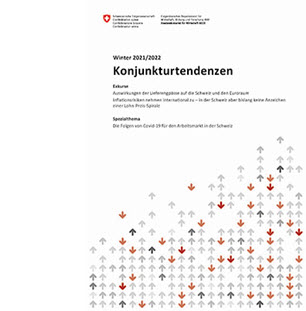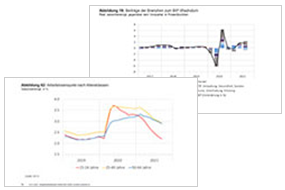Economic trends, winter 2021/2022
Every quarter, the Federal Government’s Expert Group publishes a
The winter forecast was presented on 9 December 2021 with a SECO press release and documented in a comprehensive SECO publication entitled ‘Konjunkturtendenzen’/‘Tendances conjoncturelles’ (see illustration opposite).
This publication is freely accessible online in German or French at www.seco.admin.ch/Konjunkturtendenzen.
In this task, Iconomix presents a concise summary on the basis of excerpts from the approximately 30-page publication and the press release from SECO. It then sets a number of
The summary is structured as follows: As a small economy geared to the global markets, Switzerland is heavily influenced by international economic developments. For this reason, the summary starts with an outline of the global economic situation and the monetary environment. The second section looks into the economic situation in Switzerland, while the third presents the latest economic forecast. The fourth part of the summary explains the risks to economic developments and the forecast.

Slide set with charts and tables
The Iconomix unit ‘Economic trends’ also includes a PDF slide set containing all the charts and tables from the corresponding SECO publication, covering areas such as contributions made by the various economic sectors to GDP growth, global trade and inflation trends.

Overview
In the third quarter the global economy lost momentum overall. Bottlenecks in materials, extended delivery times and massive increases in transport costs slowed the industrial sector internationally.
Real economy
Growth in the real economy in the US slowed significantly, held back in particular by weak consumer spending. In China energy shortages, problems in the real estate sector and containment measures weighed on the economy. The euro area, by contrast, was able to maintain the previous quarter’s pace of expansion, with the easing of COVID-19 restrictions enabling strong growth in the services sector.
Monetary developments
Inflation continued to rise globally in the autumn, in some cases well above the central banks’ target ranges. These high rates of inflation are due to a considerable extent to energy prices. Even in autumn, almost twice as much had to be paid for a barrel of crude oil as in the same period of the previous year. This base effect is likely to weaken noticeably in the coming months and slow inflation down.
Questions on the international and monetary environment
Describe the current global economic situation.
How would you describe monetary developments?
✪ Global supply bottlenecks and increases in transport costs are weighing on economic recovery all over the world. What do you think could be the reasons for these bottlenecks and increases in energy prices?
✪ In the SECO text, a ‘base effect’ is cited as a reason for an international rise in consumer price inflation. What does that mean exactly?
Overview
The domestic economy has continued to recover strongly as expected due to the easing of most COVID-19 restrictions up until mid-year; in the summer, GDP rose above the pre-crisis level of Q4 2019. However, international supply and capacity bottlenecks are putting pressure on the industrial sector and causing sharp price increases. In addition, the uncertainty surrounding the pandemic has recently become strongly accentuated.
Gross domestic product
In Q3 2021, robust GDP growth of 1.7% (+1.5% adjusted for sporting events) was driven in particular by the services sector in the wake of eased COVID-19 measures. There was also positive, albeit weaker, stimulus from manufacturing.
Labour market
By the end of October the unemployment rate had fallen to 2.7%, reversing two-thirds of the increase that had resulted from the crisis.
Prices
In recent months inflation has continued to rise in Switzerland, as it has abroad, reaching 1.2% in October – an above-average rate for Switzerland (where the average since 1995 has been 0.5%). However, more than half of the inflation of the previous year was due to the price of oil products.
Exchange rates
The Swiss franc has become more attractive again against the euro since September. At the end of November it was trading at CHF 1.05 per euro, the lowest rate since the outbreak of the pandemic.
Questions on the economic situation in Switzerland
What is the economic situation in Switzerland in winter 2021?
What is the situation on the labour market?
How is inflation developing?
✪ The appreciation of the Swiss franc in recent months has helped keep price increases in Switzerland low compared with the euro area and the US. Explain in one or two sentences the relationship between the value of the Swiss franc and the inflation trend in Switzerland.
Overview
All over the world supply bottlenecks are slowing industrial activity; recently the uncertainty around the pandemic has grown significantly. Against this backdrop, the expert group expects a significant slowdown in economic growth globally and in Switzerland in the 2021/22 winter period. Provided there are no severely restrictive health policy measures such as broad business lockdowns, economic recovery is not, however, expected to come to a standstill in the medium term.
Factors that have slowed down recovery should gradually dissipate in the course of 2022. Economic growth should pick up significantly, driven by catch-up effects not only in consumer spending and in investment, but also in exports.
In the second half of the forecast period, the catch-up effects will weaken and the economy is expected to normalise. The strong growth in domestic demand and the export industry should therefore gradually decrease.
GDP forecast
Overall, the expert group expects above-average growth of 3.0% in GDP adjusted for sporting events for 2022 (forecast from September: 3.4%), after 3.3% in 2021.
For 2023 as a whole, the expert group forecasts GDP growth of 2.0% (adjusted for sporting events), which is still higher than average.
Labour market
The ongoing recovery is having a clear impact on the labour market. Unemployment is likely to continue to decrease. For 2022 an annual average of 2.4% is expected, with a unemployment falling further to 2.3% in 2023.
Prices
Inflation is predicted to increase moderately to 1.1% on average for the year, owing primarily to increased prices for energy and materials; inflation rates are expected to peak in the current 2021/22 winter period. In 2023 inflation is expected to be lower again at 0.7%
Questions on the economic forecast
What GDP growth is the Federal Government’s Expert Group expecting for 2022 and 2023?
How will unemployment develop in 2022 and 2023?
✪ What is the connection between the above-average GDP growth of 3% projected for 2022 and the ‘catch-up effects’ mentioned in the text? Explain in two or three sentences.
✪ The text talks about ‘GDP adjusted for sporting events’. Why does it make sense to adjust Swiss GDP for sporting events? Give arguments.
Omicron variant
Uncertainty is currently very high and risks are tilted to the downside. In particular, there is a renewed risk of setbacks in the development of the pandemic, including in connection with the Omicron variant of coronavirus. Any severely restrictive health policy measures would greatly hinder the recovery.
Inflation and interest rates
A slowdown in the economic recovery would also be likely if the global capacity bottlenecks were to last longer than expected and inflation increases were to lead to sustained price pressure with significantly higher interest rates. Existing risks related to sovereign and corporate debt would then also be significantly exacerbated, as would risks in the domestic real estate sector.
Real estate sector in China
China’s real estate sector also poses risks globally. A property crisis with a strong impact on demand in China could weigh heavily on the global economy.
Catch-up effects
Conversely, it is also possible that the recovery in Switzerland and in other advanced economies may be stronger than assumed in the expert group’s forecast. Having had limited spending opportunities since spring 2020, some households have built up considerable savings, and these may now be released in the form of consumer spending.
Questions on the risks
There is currently a very high level of uncertainty, with risks on both the upside and the downside. Describe in your own words the most important negative risks.
There are also positive risks. Formulate these in your own words.
✪ The text talks about the fact that the observed increases in inflation could lead to sustained price pressure with significantly higher interest rates. Explain the relationship between higher long-term inflation and rising interest rates using government bonds, a fixed-rate debt security, as an example.